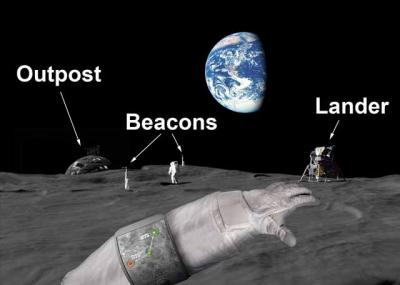
The Crazy Lune

 |
The Crazy Lune |
 |
|---|
      |
|
Omnidirectional Antenna A critical aspect of the Astronaut-Lander link is the transmit/receive antenna design. As a passive device, a good antenna design can add a moderate gain to the link at each end and buy some room for other design trade-offs. A poor design, however, can severely degrade the link, requiring costly increases in transmit power to achieve the same performance; in more extreme cases, the desired performance may not even be possible. |
|
Antenna Construction:
A quarter-wave dipole antenna design was used because it is simple, reliable, and provides uniform gain in the azimuth plane. The antenna is constructed from a copper rod mounted on a SMA connector soldered through the center of a 5" x 5" copper ground plane, as shown in Figure 1. The rod length was carefully trimmed to a quarter-wavelength (3.75 cm) for the desired center frequency (2.0 GHz). The antenna was tested at the Remote Educational Antenna Laboratory (REAL) at Carnegie Mellon University. Return loss was measured using a vector network analyzer, and the antenna isotropic gain was measured in reference to a standard horn antenna within the REAL antenna chamber. A picture of the antenna mounted on the test stage is shown in Figure 2.
Antenna Performance:
The return loss of the antenna is plotted in Figure 3. Excellent matching is achieved at 2.0 GHz, and the return loss remains below -10 dB for the frequency range from 1.75-2.25 GHz. This provides full freedom in choice of bandwidth during the link design, since 500 MHz is substantially more bandwidth than could be used for a digital link across several kilometers at feasible power levels.
Good uniformity of gain across azimuth for the frequency range from 1.8-2.2 GHz is displayed in Figure 4. The gain pattern in the azimuth plane at the center frequency is shown in Figure 5. At the center frequency, the maximum gain is 0.84 dBi, minimum gain is -4.29 dBi, and average gain across azimuth is -1.66 dBi. Figure 6 plots the gain patterns across the frequency band of interest (1.95-2.05 GHz). The average gain across frequency and azimuth is given by the dashed line; this gain clearly provides a reasonable estimate of the actual gain and is therefore used for all subsequent link calculations.
The gain pattern in the elevation plane is shown in Figures 7 and 8. The fact that the peak gain of 3.27 dBi occurs at ~30 degrees elevation indicates that in measurement the antenna may not have been installed in the ideal orientation. This would cause the azimuth measurements to underestimate the actual gain. Nevertheless, when deployed on an astronaut's spacesuit, the antenna will not remain fixed in the ideal orientation, so this is indeed a more realistic estimate of the antenna performance. As such, the average gain value used in our link budget calculations can be considered to be a worst-case estimate. So yes, the astronaut can still stream video when he bends down to pick up a rock!
|
Home | Project | Communication | Location | Power | Budget & Timeline Tuesday, December 8, 2009 © 2009 The Crazy Lune. All rights reserved. |